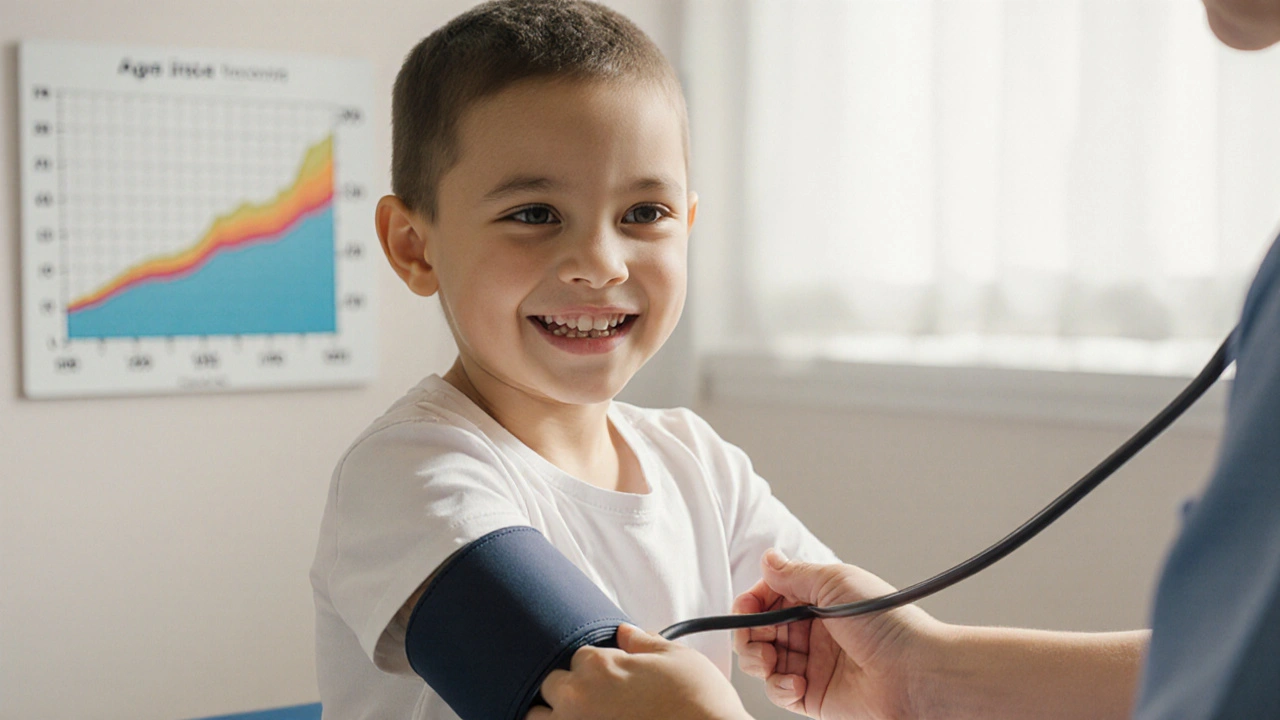SEARCH
Pediatric Hypertension: Causes, Signs & Treatment Guide


Pediatric Hypertension Risk Calculator
Child Information
Risk Assessment Result
Understanding Percentiles for Children
Blood pressure in children is assessed using age-, sex-, and height-adjusted percentiles. A reading above the 95th percentile indicates elevated blood pressure.
| Percentile | Description |
|---|---|
| Below 90th | Normal |
| 90th–95th | Elevated |
| Above 95th | Hypertensive |
Hypertension in Children is a medical condition where a child’s blood pressure consistently reads above the 95th percentile for their age, sex, and height. While many parents first think high blood pressure only affects adults, pediatric cases are rising, especially in places with high obesity rates. This guide breaks down why it happens, what to look for, and how doctors treat it so you can act early and keep your child healthy.
Key Takeaways
- High blood pressure in kids is defined by age‑adjusted percentiles rather than a single number.
- About 80% of cases are primary hypertension, linked to lifestyle factors like obesity and excess sodium.
- Secondary hypertension, driven by conditions such as kidney disease or hormonal disorders, accounts for the remaining 20%.
- Common signs include headaches, blurry vision, and nosebleeds, but many children feel fine.
- Treatment starts with lifestyle changes and escalates to medication if needed.
Understanding Blood Pressure in Kids
Unlike adults, where a reading above 130/80mmHg flags concern, children need a percentile chart. A 10‑year‑old boy at the 95th percentile might have a systolic pressure of 122mmHg, while a teenager could be normal at 130mmHg. Doctors use these charts during well‑child visits, often noting trends over several appointments before labeling it hypertension.

Primary vs. Secondary Causes
Distinguishing between primary (essential) and secondary hypertension helps guide treatment. Primary hypertension is largely linked to modifiable risk factors, whereas secondary hypertension stems from an underlying disease.
| Aspect | Primary Hypertension | Secondary Hypertension |
|---|---|---|
| Typical Causes | Obesity, high sodium intake, sedentary lifestyle | Kidney disease, coarctation of the aorta, endocrine disorders (e.g., hyperthyroidism) |
| Age of Onset | Usually after 10years | Can appear at any age, often younger |
| Blood Pressure Pattern | Gradual rise, often isolated systolic | Sudden, sometimes severe elevations |
| Diagnostic Focus | Lifestyle review, basic labs | Imaging, extensive labs, specialist referral |
| Treatment Approach | Weight management, diet, exercise, possible medication | Treat underlying disease + antihypertensive meds |
Common Symptoms Parents Should Notice
Many children with high blood pressure feel normal, which is why routine checks are crucial. When symptoms do appear, they may include:
- Frequent or severe headaches, especially after school.
- Blurred vision or occasional vision loss.
- Nosebleeds without a clear cause.
- Tiredness or reduced exercise tolerance.
- Chest discomfort (rare but warrants immediate care).
If you notice any of these, schedule an appointment with your primary care physician promptly.
How Diagnosis Is Made
Doctors start with three separate blood pressure readings taken on different days. If these stay above the 95th percentile, they move to confirmatory tests:
- Ambulatory blood pressure monitoring (ABPM): A portable cuff records pressures over 24hours, revealing hidden spikes.
- Basic labs: serum creatinine, electrolytes, fasting glucose, and lipid profile.
- Urinalysis: looks for protein or blood that might signal kidney involvement.
- Imaging (when secondary causes are suspected): renal ultrasound, echocardiogram, or MRI of the aorta.
These tests help pinpoint whether the hypertension is primary or secondary and guide the next steps.

Treatment Options Overview
Management is a stepwise process, beginning with the least invasive measures.
1. Lifestyle Changes
Weight reduction is the single most effective intervention. For every kilogram lost, systolic pressure can drop 1-2mmHg. Key components:
- Diet: Adopt a DASH‑style diet-rich in fruits, vegetables, whole grains, and low‑fat dairy. Limit processed foods high in sodium intake to under 1,500mg per day.
- Physical activity: Aim for at least 60 minutes of moderate‑to‑vigorous activity daily (e.g., cycling, swimming, team sports).
- Screen time reduction: Less than 2 hours of sedentary screen time helps control weight and stress.
2. Medication
If blood pressure remains above target after three months of lifestyle effort, doctors consider antihypertensive medication. Common first‑line choices include:
- ACE inhibitors (e.g., enalapril) - useful when kidney involvement is present.
- ARBs (e.g., losartan) - similar efficacy with fewer cough side effects.
- Calcium‑channel blockers (e.g., amlodipine) - effective for isolated systolic hypertension.
Dosage is weight‑based and titrated slowly. Regular follow‑up labs monitor kidney function and electrolytes.
3. Treating Underlying Conditions
When a secondary cause is identified, fixing that disease often normalizes blood pressure. For example, surgical correction of coarctation of the aorta or managing chronic kidney disease with nephrologist‑guided therapy can eliminate the need for long‑term antihypertensives.
Managing at Home & When to Seek Help
Even after treatment begins, families play a vital role:
- Track home blood pressure readings using a validated pediatric cuff.
- Maintain a food diary to watch hidden sodium sources.
- Encourage regular physical activity-a family walk after dinner works well.
- Know red‑flag symptoms: sudden severe headache, vision loss, chest pain, or a blood pressure reading that spikes above the 99th percentile.
If any red‑flag appears, head to the emergency department immediately. Early intervention can prevent lasting cardiovascular complications such as left‑ventricular hypertrophy.
Frequently Asked Questions
How is hypertension diagnosed in a preschool‑aged child?
Doctors use age‑adjusted percentile charts. If three separate visits show systolic or diastolic pressures above the 95th percentile, they repeat measurements with a properly sized cuff and may order ABPM to confirm.
Can a child’s blood pressure be normal one day and high the next?
Yes. Blood pressure fluctuates with stress, activity, and even caffeine. That’s why clinicians require multiple readings over weeks before making a diagnosis.
Is medication safe for kids?
When prescribed at the correct dose, antihypertensives are safe. Side‑effects are closely monitored, and most children tolerate them well, especially ACE inhibitors and ARBs.
How much sodium should a child consume daily?
The American Heart Association recommends less than 1,500mg per day for kids aged 2‑18. Reading nutrition labels and limiting processed snacks helps hit this target.
Will my child outgrow hypertension?
If it’s primary hypertension linked to obesity, sustained lifestyle changes can normalize blood pressure as the child matures. Secondary hypertension usually improves only when the underlying disease is treated.
Understanding pediatric hypertension equips you to catch problems early, work with healthcare providers, and create a healthier future for your child.
Holly Hayes
October 6, 2025 AT 17:15In the grand tapestry of paediatric cardiometabolic health, one cannot simply dismiss the nuance of percentile‑based diagnostics. The guide’s emphasis on lifestyle modification feels almost pedestrian, yet the data is undeniably robust. However, the occasional typographical slip (like “obesitiy”) betrays a superficial veneer.
Matthew Shapiro
October 10, 2025 AT 22:54The risk calculator does a decent job of translating raw numbers into actionable insight, but remember that consistent measurement technique is key. Ensure the cuff size matches the child’s arm circumference to avoid skewed readings. Regular follow‑up appointments can catch trends before they cement into chronic hypertension.
Julia Phillips
October 15, 2025 AT 04:33Oh, the sheer weight of watching your little one’s numbers creep upward-it’s like a silent storm gathering on the horizon. I remember the anguish of puzzling over a sudden headache after a school exam, fearing it was more than just stress. Your child’s resilience can be bolstered by simple shifts: swapping soda for water, turning screen time into backyard adventures, and sharing meals that celebrate colour. The emotional toll of uncertainty is real, and it’s okay to feel overwhelmed; you’re not alone in this marathon. Together, families and clinicians can rewrite the narrative from inevitability to empowerment.
Richa Punyani
October 19, 2025 AT 10:11Your child’s health truly deserves the utmost dedication.
Bhupendra Darji
October 23, 2025 AT 15:50Collaboratively, we should view the lifestyle adjustments as a family project rather than a solitary chore. Involving siblings in cooking nutritious meals often turns the kitchen into a learning lab. Moreover, tracking progress with a simple chart can motivate the child by visualising improvement over weeks. Let’s keep the dialogue open with the pediatrician to tailor interventions as the child grows.
Robert Keter
October 27, 2025 AT 21:29When confronting pediatric hypertension, the first battle is often psychological-both for the child and the caregivers. Accepting that blood pressure can be a moving target, subject to stress, activity, and even the time of day, reframes the narrative from blame to management. The guide wisely points out that a 10‑year‑old with a BMI over 25 faces a heightened risk, yet the underlying mechanisms are multifaceted, involving insulin resistance, sympathetic overdrive, and endothelial dysfunction. Each kilogram of excess weight can add a couple of millimetres of mercury to systolic pressure, a fact that underscores the power of even modest weight loss. Dietary overhaul, anchored by the DASH diet, reduces sodium intake, enriches potassium, and supplies antioxidants that soothe vascular inflammation. Physical activity, preferably aerobic, improves arterial compliance, and the recommendation of 60 minutes daily is both evidence‑based and achievable with creative play. Monitoring at home with a validated pediatric cuff demystifies the numbers, turning them from abstract fear into concrete data points. When the numbers persist above the 95th percentile despite these measures, pharmacologic therapy becomes reasonable, with ACE inhibitors and ARBs leading the pack due to renal protective effects. Proper dosing, calibrated to the child’s weight, minimizes side‑effects and allows titration as growth proceeds. Regular lab work, particularly checking electrolytes and renal function, ensures safety and guides adjustments. Moreover, secondary causes such as renal artery stenosis or endocrine disorders must never be overlooked; a thorough work‑up can uncover treatable culprits. Engaging the child in the decision‑making process fosters autonomy and adherence, turning a medical mandate into a partnership. Schools can also play a role by offering healthier lunch options and encouraging active recesses. Ultimately, the journey from diagnosis to control is a marathon, not a sprint, demanding patience, consistency, and a supportive network. By integrating these strategies, families can dramatically reduce the long‑term cardiovascular sequelae, granting the child a healthier horizon.
Rory Martin
November 1, 2025 AT 03:08One cannot overlook the subtle orchestration of pharmaceutical interests that have quietly shaped pediatric guidelines. The emphasis on early medication, despite modest evidence, appears designed to expand market share for antihypertensives. Such trends warrant vigilant scrutiny, lest we compromise the child’s well‑being for corporate profit.
Maddie Wagner
November 5, 2025 AT 08:47Imagine a world where every child’s heartbeat sings in harmony with a balanced diet and joyous play; that vision is within reach if we rally as a community. Swapping processed snacks for crunchy carrots not only trims sodium but also sparks a sense of adventure at the dinner table. Let us champion these small victories, for they compound into a robust defense against hypertension.
Boston Farm to School
November 9, 2025 AT 14:25Kids need a simple plan 🏃♀️ eat less salty food drink water and move daily 🍎😊
Emily Collier
November 13, 2025 AT 20:04In the grand equation of health, each mindful choice adds a positive variable, shifting the balance toward longevity. Embracing the principles of the DASH diet becomes a meditation on self‑care, nurturing both body and spirit. Let us walk this path with hope, trusting that consistency will illuminate brighter outcomes for our children.
Catherine Zeigler
November 18, 2025 AT 01:43As a coach, I remind you that progress is built on incremental steps, not sudden leaps. Celebrate the tiny victories-like a 5‑minute bike ride or a veggie added to lunch-because they aggregate into lasting change. Consistency in these habits creates a resilient foundation that steadies blood pressure over time. Encourage open dialogue with your child, framing health decisions as shared adventures rather than imposed duties. Remember, setbacks are merely detours, not dead ends, and they offer valuable learning moments. Keep the momentum alive, and the results will follow.